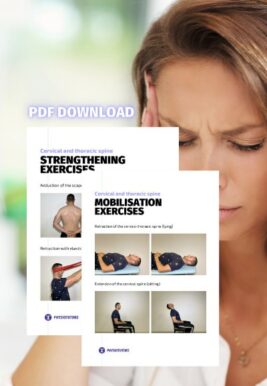Learn
Cervicogenic Headache | Headache & Dizziness Assessment
Headaches can manifest on their own but are also a very common symptom in neck pain patients as more than 60% of patients with a primary neck pain complaint report having concordant episodes of neck pain. Therefore it’s essential to find out what kind of headache the patient is suffering from.
To start off let’s differentiate between primary and secondary types of headaches. But what does this mean? Simply put, primary headaches are a “disease themselves” whereas, in secondary headaches, the headache is a symptom of another condition. So primary headaches would be migraines, tension-type headaches & cluster headaches. Secondary-type headaches are headaches caused by tumors, hemorrhage, other trauma, TMJ dysfunction, substance overdose, or neck pain aka the Cervicogenic headache.
Now let’s take a closer look at cervicogenic headache, which is a secondary type of headache.
Cervicogenic headache has a prevalence of 0.7 to 4% and as the name suggests, it is a headache caused by a disorder involving the cervical spine and its bony, disc, and/or soft tissue elements and is usually but not invariably accompanied by neck pain.
In order for a headache to qualify as cervicogenic headache it has to fulfill certain criteria:
First and foremost, there will be clinical, laboratory, and or imaging evidence of a disorder or lesion in the cervical region known to be able to cause headaches such as for example the facet joints or certain muscles.
Furthermore, at least two of the following criteria have to apply:
- the headache has developed after the onset of the cervical disorder or lesion. So patients will probably describe a trauma during patient history.
- the headache improves or resolves in parallel with improvement in or resolution of the cervical disorder or lesion
- The cervical range of motion is reduced, the pain is movement/posture dependent, and the headache is made significantly worse by provocative testing. For example, Decreased upper cervical spine rotation as assessed by the flexion rotation test can be linked to cervicogenic headache, you can watch this assessment by a click on the info icon in the top right corner!
- The headache is abolished after diagnostic blockade of a cervical structure or its nerve supply
100% FREE HEADACHE HOME EXERCISE PROGRAM

Tools you can use to assess the impact of a headache on your patient are the HIT-6 questionnaire which you can find in the video description. Also note that it can be difficult for a patient to answer all of the questions on duration, intensity, and characteristics of their headache during your assessment. Therefore asking them to complete a headache diary can help in the assessment and management of the headache and you should be aware that there can be overlap between multiple headache disorders.
If you would like to learn how to diagnose other common forms of headaches, check out the posts below:
The Watson Test is a common provocation test used in the assessment of tension-type headaches and migraines.
References:
Like what you’re learning?
BUY THE FULL PHYSIOTUTORS ASSESSMENT BOOK
- 600+ Pages e-Book
- Interactive Content (Direct Video Demonstration, PubMed articles)
- Statistical Values for all Special Tests from the latest research
- Available in 🇬🇧 🇩🇪 🇫🇷 🇪🇸 🇮🇹 🇵🇹 🇹🇷
- And much more!








